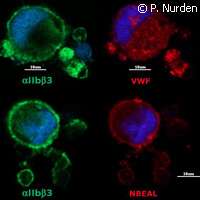Scientists find elusive gene responsible for rare congenital disease

A Franco-British team of researchers has discovered a mysterious gene responsible for the extremely rare congenital Grey Platelet Syndrome that causes a bleeding disease. Only 50 cases have been reported to date. The team hopes that the results of their study will lead to the development of a DNA (deoxyribonucleic acid) test able to diagnose the disease. The findings are published in the journal Nature Genetics.
Platelets are the second most popular cells in the blood, and their primary role is to assess the blood vessel wall for damage. They are also responsible for organising the repair work of a vessel wall when needed. But platelets also have a 'dark side'. When vessel walls are damaged, platelets could potentially generate blood clots that lead to stroke or heart attack in patients.
Thanks to this latest study, headed by Professor Willem Ouwehand and Dr. Cornelis Albers from the Wellcome Trust Sanger Institute and the University of Cambridge in the United Kingdom, along with colleague Dr Paquita Nurden of the Laboratoire d'Hématologie, Centre de Référence des Pathologies Plaquettaires, Hopital Xavier Arnozan in France, scientists can obtain greater insight on how to best diagnose patients at risk.
Experts say there are people who are born with dysfunctional platelets, and most believe that this disorder is inherited. Grey Platelet Syndrome can trigger severe and life-threatening cases as the risk of bleeds increases, particularly if they occur in the brain.
The disease was first identified in the 1970s. Named for the greyish appearance of these platelets under the microscope, Grey Platelet Syndrome has prevailed against researchers who have tried relentlessly to determine the cause of this disease and the increased bleeding in young patients.
The experts point out that there is a huge need for the research world to acquire simpler and faster DNA-based diagnostic tests; this is particularly important when it comes to translating research findings in human genetics and to developing better patient care.
The team believed it was crucial for them to identify the gene responsible for this rare bleeding disorder. It couldn't be done before because researchers had to first identify and genetically analyse several large families affected by the same disorder. In order to get a handle on the issue, the researchers used a simpler approach and worked out some 40 million letters of genetic code covering the entire coding fraction of the genome of 4 non-related French patients.
According to the scientists, NBEAL2 is a dysfunctional gene in Grey Platelet Syndrome. It is part of the family of genes that contain the unique domain called BEACH. In this study, the team demonstrated that the protein encoded by this gene is altered at a different position in the four non-related cases; the patients affected by the disorder have inherited two non-functioning copies of the gene (i.e. one from each parent).
"It is really great to see how the use of modern genomics technologies is going to be of direct benefit for patient care," says Professor Ouwehand. "This study is one such example and it gives us confidence to achieve the same for a large number of other rare inherited platelet bleeding disorders. It is now important that we use this discovery to improve patient care in the National Health Service and beyond."
They also confirmed the identification of the NBEAL2 gene in zebrafish, which have platelets (called thrombocytes). When the NBEAL2 gene was switched off in the fish, triggering a 100% absence of these cells, almost 50% of the fish suffered spontaneous bleeds like those found in patients with the disorder.
Commenting on the findings, Dr. Albers says: "Our discovery that another member of the family of BEACH proteins is underlying a rare but severe granule disorder in platelets firmly nails down the important role of this class of proteins in granule biology. The reasons why the platelets of patients with Grey Platelet Syndrome are grey is because they lack alpha granules. The alpha granules carry the cargo of proteins that induce vessel wall repair and also form the platelet plug. A better understanding of how these granules are formed and how their timely release by the platelet is coordinated at the molecular level may one day underpin the development of a new class of safer anti-platelet drugs for use in patients with heart attacks and stroke. It has been a fascinating journey to identify a new and important pathway by combining the rapid advances in sequencing technology with computational analysis."
More information: Albers, C. et al. (2011) 'Exome sequencing identifies NBEAL2 as the causative gene for Grey Platelet Syndrome'. Nature Genetics, published online 17 July. DOI: 10.1038/ng.885















